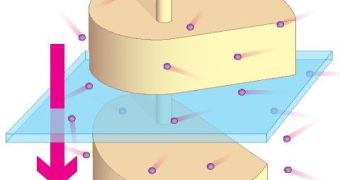A Brownian motor represents a nanoscale motor that can be used to convert random thermal motion of molecules into mechanical or electrical work. These tiny devices can only operate on the nanoscale where the viscosity and inertia are the dominant forces, and thermal noise makes moving in a specific direction almost impossible. Because the Brownian motors are strongly dependent on the thermal noise, they are very likely to be able to work only in nanometer scales.
In 1827, the random thermal motion of particles in liquids was discovered by Robert Brown and ever since then scientists have tried to find a way to harness this random motion and convert it into useful work. The increasing interest in the Brownian motors and refrigerators came as a direct result of the focus on nanotechnologies to find a way these devices could be used.
For example, computer simulations were used to show that the Brownian motion could be exploited in order to create rotating machines, working between two baths with different temperatures, which could also be used to make nanorefrigerators that could be helpful in transferring heat from a warm region to a cooler one, by means of specially designed paddles.
In fact, the whole secret of the motor's workings consists in the design of the paddles. The snail-shaped spiral rotors designed by Van den Broeck at the Hasselt University are attached to the axle and separated by two baths with a thin membrane, one of the paddle siting in a diluted warm gas, while the other in a concentrated cool one.
The motor presents two basic functions and can work as a motor or refrigerator. The device works as a motor when the particles inside the bath of diluted warm gas collide with the rotor and convert part of the kinetic energy into rotation to transfer it into the cool bath of gas. Simulations show that the motor working in such conditions could have rotation speeds as high as a few thousand rotations per second, a factor greatly depending on the difference of temperature between the baths.
The same simulations show that, when the motor is supplied by an external power source, it can spin the device in the opposite direction and use it to transmit kinetic energy from the cool gas to the warm one, meaning it basically works like a heat pump. Also, results suggest that the rotors need to be between 4 and 10 nm thick and 5-12 nm across, but the biggest challenge consisted in finding the right shape.
This is essential in boosting the ability to convert the Brownian motion with little friction while rotating to ensure the efficiency of the device. The preferable material to create the nanometer motors and refrigerators would be carbon nanotubes, since the research in creating the material is quite advanced.

 14 DAY TRIAL //
14 DAY TRIAL //